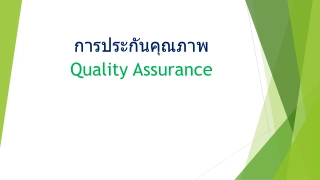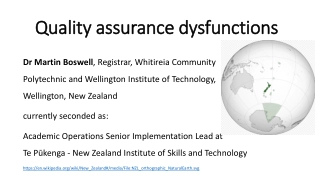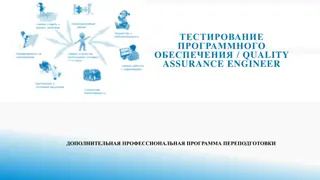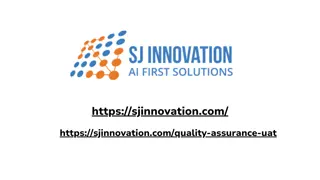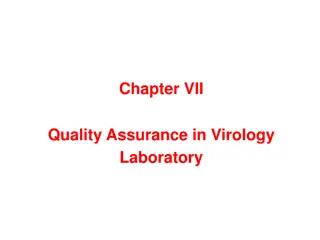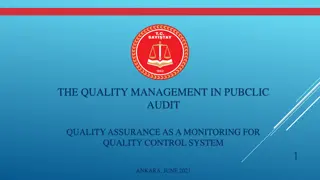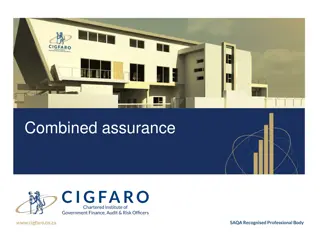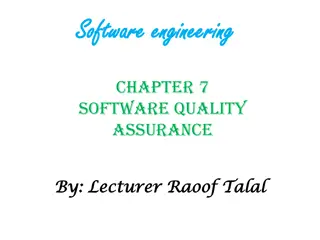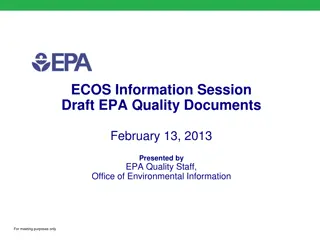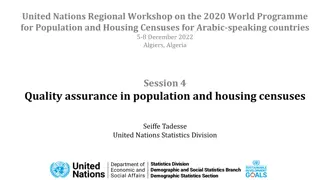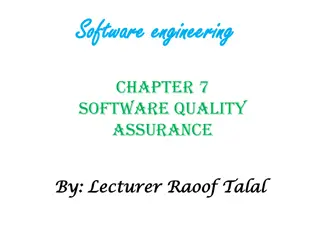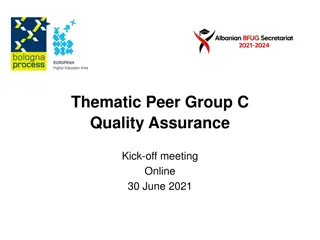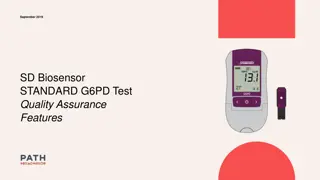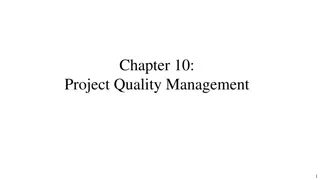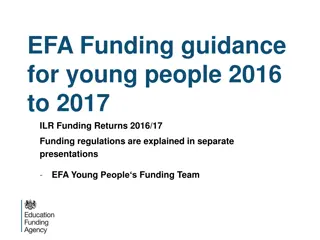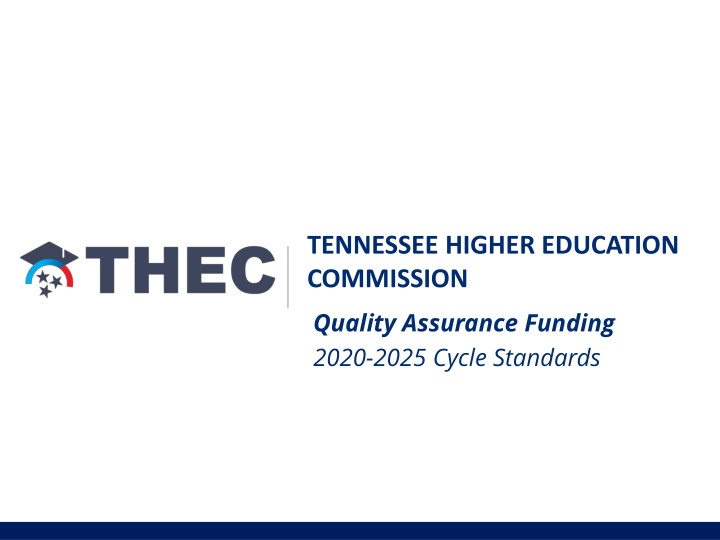
Tennessee Higher Education Commission: Quality Assurance Funding Overview
The Tennessee Higher Education Commission (THEC) has a history of implementing quality assurance funding initiatives since 1974, with a focus on outcomes-based strategies. The current 2020-2025 cycle emphasizes equity, collaboration, and standards review processes involving institutions and governing bodies. Significant shifts include increased emphasis on accreditation, student equity standards, and aligning with outcomes-based funding. The revised standards for 2020-2025 cover areas such as general education, major field assessment, academic programs, institutional satisfaction, student equity, job placement, and more.
Download Presentation

Please find below an Image/Link to download the presentation.
The content on the website is provided AS IS for your information and personal use only. It may not be sold, licensed, or shared on other websites without obtaining consent from the author. If you encounter any issues during the download, it is possible that the publisher has removed the file from their server.
You are allowed to download the files provided on this website for personal or commercial use, subject to the condition that they are used lawfully. All files are the property of their respective owners.
The content on the website is provided AS IS for your information and personal use only. It may not be sold, licensed, or shared on other websites without obtaining consent from the author.
E N D
Presentation Transcript
TENNESSEE HIGHER EDUCATION COMMISSION Quality Assurance Funding 2020-2025 Cycle Standards
History of Quality Assurance Funding Planning begins with collaboration between higher education institutions, governing boards, national advisory panel and THEC 1974 Tennessee first state to utilize outcomes for state funding Institutions earn up to 2% over operating budget 1978-1982 Emphasis shifts from process of assessment to performance outcomes Institutions earn up to 5.45% over operating budget 1988-1992 2000-2005 Aligned with Master Plan 2005-2010 Focus on Articulation and Transfer 2010-2015 Shift retention and graduation rates to Outcomes Based Funding (OBF) Name change to Quality Assurance Funding (QAF) to distinguish mission from OBF 2015-2020 2020-2025 Strengthen dedication to equity across student populations 2
Standards Review Process Collaboration between institutions, governing boards and THEC staff every 5 years Standards approved at May 2020 THEC meeting 2020-25 QAF Advisory Committee TN Board of Regents Locally Gov Institutions Dr. Lana Hamilton Vice Chancellor for Acad. Affairs, TBR Dr. Donna Seagle VP for Acad Affairs Walters Associate Provost, TTU Dr. Chris Whaley President, Roane President, UOM University of Tennessee Dr. Linda Martin VP Acad. Affairs & Student Success, UT Dr. Philip Cavalier Provost, UT Martin Dr. David Manderscheid, Provost, UT Knoxville Dr. Mark Byrnes Provost, MTSU Dr. Sharon Huo Dr. David Rudd 3
Significant Shifts Increase points associated with accreditation Student Equity standard Calculations place further emphasis on quality Alignment with OBF on exclusion of academic certificates at community colleges 4
2020-25 QAF Standards Revisions QAF Cycle Revisions Standard 1. General Education 2. Major Field Assessment 3. Academic Programs o Specialty Accreditation o Program Evaluation 4. Institutional Satisfaction 5. Student Equity Adult Learner Success 6. Job Placement 7. Student Access & Success TOTAL Community College 2015-20 15 15 15 5 10 10 - 10 10 25 100 University 2015-20 15 15 25 5 20 10 - 10 NA 25 100 2020-25 10 15 25 15 10 10 10 - 10 20 100 2020-25 10 15 35 15 20 10 10 - NA 20 100 5
General Education (10 points) Purpose: Provide incentives to institutions for improvements in the quality of undergraduate general education programs as measured by the performance of graduates on an approved standardized assessment of general education Revision: Adjust points from 15 to 10 Include CAT Assessment as option 6
Major Field Assessment (15 points) Purpose: Provide incentives for institutions to improve the quality of major field programs as evaluated by the performance of graduates on approved examinations Revisions Exemption reviews - completed Participation level accountability in scoring Scoring focus on excellence, not perfection Reminders New local test development is 3 year process (Appendix C) Programs established through concentration elevation do not receive 3 year exemption from MFT. 7
Academic Programs (25 CC, 35 Univ) Purpose: Provide incentives for institutions to achieve and maintain academic program excellence and specialty program accreditation Accreditation Revisions Points increased from 5 to 15 points Worksheets for programs seeking accreditation or having substantial delays (Appendices E1 & E2) Program Evaluation Revisions None for Community Colleges Universities may only utilize Program Reviews Appendices F Program Review & I Academic Audit 8
Accreditation Worksheets (Appendix E1 & E2) New Academic Programs: programs approved by THEC or TBR after August 1, 2020 complete within 90 days and update annually with QAF submission Current Academic Programs: programs approved prior to August 1, 2020, complete worksheet with for QAF submission in August 2021 and update annually Accreditation Delays: programs that have experienced delays/deferrals in progress, significant citations/warnings, or lost accreditation complete worksheet and update annually with QAF submission 9
Institutional Satisfaction (10 points) Purpose: Provide incentives for institutions to improve the quality of their undergraduate programs as evaluated by surveys of students and alumni Schedule by Sector Cycle Year Community Colleges Year 1: 2020-21 Student Engagement Year 2: 2021-22 Engagement Year 3: 2022-23 Student Engagement Year 4: 2023-24 Year 5: 2024-25 Universities National Survey of Student Engagement Community College Survey of Survey of Entering Study Qualitative Analysis Report Community College Survey of Alumni Survey National Survey of Student Engagement Alumni Survey (or SENSE) Comprehensive Report Comprehensive Report 10
Student Equity (10 points) Purpose: Incentivize institutions to qualitatively and quantitatively improve outcomes for students historically underserved by higher education Selection:Appendix L Retention Methodology: Full-time, fall-to-fall retention Student Equity Scoring Indicators Year 2020-21 2021-22 2022-23 2023-24 Qualitative Indicators Self-Assessment Action Plan Status Report Status Report Comprehensive Report Quantitative Indicators Retention Retention Retention Retention 4 points 4 points 4 points 4 points 6 points 6 points 6 points 6 points 2024-25 4 points Retention 6 points 11
TN Job Market Placement (10 points) Purpose: Provide incentives for community colleges to continue to improve job placement of graduates in the Tennessee job market TN Job Market Placement Rate (Graduates working full-time Graduates with unemployment claim) Graduates working full- time = Revisions: None Reminder: THEC provides data in early October of reporting year from TN Longitudinal Data System. 12
Student Access & Success (20 points) Purpose: Provide incentives for institutions to increase the quality of services dedicated to students from select focus populations Revisions Institutions select 4 populations (previously 5) Must include at least one of the following: African-American, Hispanic, Students of Color, or Low Income Calculate as awards per 100 FTE where appropriate Remove academic certificates from calculations Selection: Appendix N 13
Focus Populations by Calculation Method Percent Awards per 100 FTE 1. Academically Underprepared (community college only) 2. African American 3. First Generation Award Count 1. Associate Degree Graduates Enrolled at Public Universities (community college only) 2. Baccalaureate Degree Graduates with Previously Earned Associate Degree (univ only) 3. High-Needs Programs Graduate Degrees, STEM & Healthcare 4. Geographic High Need Area 5. Historically Underserved Populations Graduate Degrees (Racial Minority or Low-Income) 6. Hispanic 7. Low-Income 8. Males 9. SPARC Counties (economically distressed & at-risk) 10. Veterans (self-reported) 4. High-Needs Programs Undergraduate Degrees, STEM & Healthcare 14
Example FTE Calculation African Americans: Awards Per 100 FTE Calculation Year 2 Awards 100 FTE 100 FTE 15.9 737 134 18.2 22.4 125 28 22.4 19.6 251 40 15.9 29.4 279 63 22.6 18.4 434 63 14.5 19.5 298 40 13.4 16.8 1,676 310 18.5 29.7 98 21 21.4 17.6 443 91 20.6 15.7 100 23 23 13.7 3,299 478 14.5 19.8 490 91 18.6 46.5 108 48 44.5 16.8 8,338 1,430 17.2 Year 1 Awards Year 3 Awards Year 4 Awards CC FTE FTE Awards Awards FTE Awards 100 FTE 21 24.1 14.9 24.6 17.3 16.1 19 19.5 21.3 24.1 21.2 22.9 39 20.6 FTE Awards 100 FTE 22.1 32.7 16.9 31.5 14.9 20.2 23.3 26.3 25.4 25.9 19.4 19.3 32.8 21.2 ChSCC ClSCC CoSCC DSCC JSCC MSCC NaSCC NeSCC PSCC RSCC STCC VSCC WSCC Avg 837 143 255 279 435 230 1,767 98 459 96 3,712 435 90 8,836 133 32 50 82 80 45 297 29 81 15 510 86 42 1,482 639 120 261 269 421 354 1,549 103 400 100 3,115 468 108 7,907 134 29 39 66 73 57 294 20 85 24 660 107 42 1,630 594 107 283 261 436 387 1,429 99 462 100 3,469 497 122 8,246 131 35 48 82 65 78 333 26 117 26 673 96 40 1,750 African American: Awards Per 100 FTE by Sector Average Year 1 Year 2 Community College 16.8 17.2 Sector Year 3 20.6 3 Yr Avg 18.2 Year 4 21.2 Percent 116% 15
Resources 2020-25 Quality Assurance Funding Guidebook Victoria Harpool Sr. Director for Academic Affairs and Strategic Alignment Victoria.harpool@tn.gov Office: 615-741-0745 Cell: 615-218-1230 16


